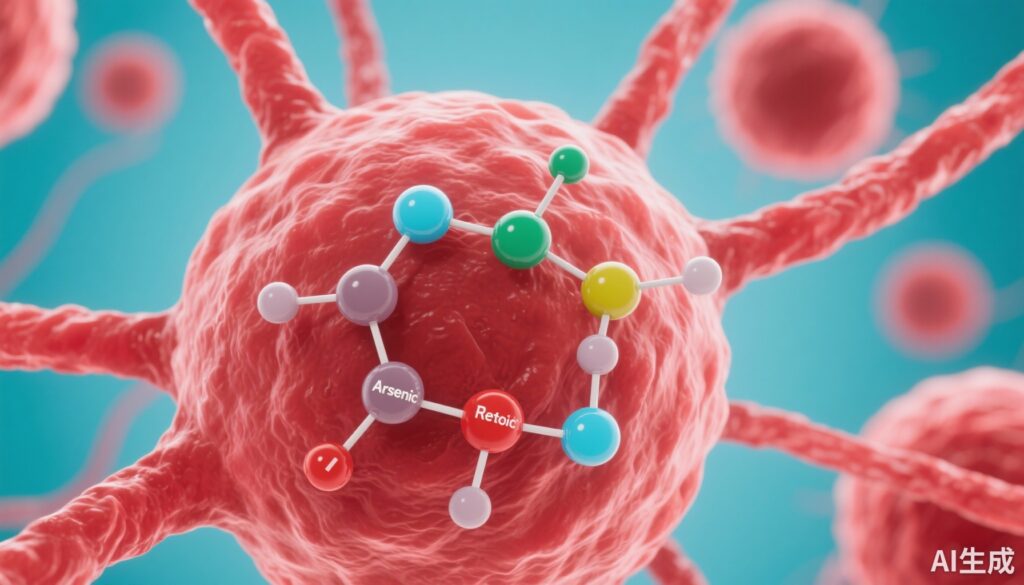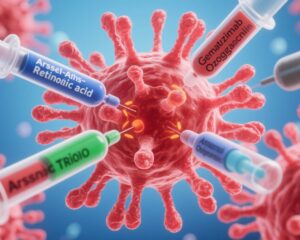Highlight
The APOLLO trial, a phase III study, compared the arsenic trioxide (ATO) and all-trans retinoic acid (ATRA) combination plus low-dose idarubicin regimen against standard ATRA plus anthracycline-based chemotherapy in adult patients with high-risk acute promyelocytic leukemia (APL). Results revealed significantly improved 2-year event-free survival (EFS) with ATRA-ATO (88%) versus ATRA-CHT (71%), and a lower molecular relapse rate (1.5% vs 12.3%). The ATRA-ATO regimen also demonstrated a favorable safety profile with markedly fewer serious treatment-emergent adverse events (32% vs 68%). These data support ATO plus ATRA as a highly effective and less toxic frontline therapy option for high-risk APL.
Study Background and Disease Burden
Acute promyelocytic leukemia (APL) is a distinct subtype of acute myeloid leukemia characterized by a translocation involving the retinoic acid receptor alpha (RARA) gene, leading to differentiation arrest of promyelocytes. Historically, APL was highly fatal due to coagulopathy and bleeding complications. However, the introduction of all-trans retinoic acid (ATRA) dramatically transformed outcomes by promoting leukemic cell differentiation, with further improvements achieved by adjunctive anthracycline chemotherapy.
Despite these advances, high-risk APL—defined by white blood cell counts exceeding 10 x 109/L at diagnosis—remains challenging, associated with higher relapse rates and mortality. Standard treatment involves ATRA combined with intensive anthracycline chemotherapy, which carries risks of significant toxicity, including cardiotoxicity and myelosuppression.
Arsenic trioxide (ATO), a potent inducer of leukemic cell apoptosis and differentiation, has demonstrated remarkable efficacy in low- and intermediate-risk APL, often allowing chemotherapy-free regimens. Nevertheless, the role of ATO combined with ATRA in high-risk patients, particularly with reduced chemotherapy intensity, has not been established in prospective randomized trials until recently.
Study Design
The APOLLO trial (EudraCT 2015-01151-68; NCT02688140) was a phase III, prospective, randomized multicenter study that enrolled adult patients with newly diagnosed high-risk APL. Patients were randomized to either:
- ATRA-ATO arm: ATO 0.15 mg/kg once daily plus ATRA 45 mg/m2 twice daily until complete remission (CR), combined with low-dose idarubicin 12 mg/m2 administered on days 1 and 3 of induction. Consolidation comprised four cycles of combined ATRA-ATO.
- ATRA-CHT arm: Induction with ATRA 45 mg/m2 twice daily plus idarubicin 12 mg/m2 on days 1, 3, 5, and 7, followed by three cycles of chemotherapy-based consolidation and two years of maintenance therapy including ATRA and chemotherapy.
The primary endpoint was event-free survival (EFS) at 2 years, defined as survival without relapse or treatment failure.
Key Findings
The trial enrolled 133 eligible patients (68 in the ATRA-ATO arm and 65 in the ATRA-CHT arm) but was prematurely discontinued due to slow accrual during the COVID-19 pandemic. After a median follow-up of 37 months (range, 1.7-88.6 months), the following results were observed:
- 2-year Event-Free Survival: 88% in the ATRA-ATO arm versus 71% in the ATRA-CHT arm, yielding a hazard ratio (HR) of 0.4 (95% CI, 0.17 to 0.92; P = .02).
- Molecular Relapse: Molecular relapse at a median of 7.8 months from CR occurred in only 1 patient (1.5%) in the ATRA-ATO arm compared to 8 patients (12.3%) in the ATRA-CHT arm (P = .014), demonstrating superior molecular remission durability with ATRA-ATO.
- Safety Profile: Serious treatment-emergent adverse events were significantly less frequent with ATRA-ATO (32%) than with ATRA-CHT (68%) (P < .01), reflecting the reduced toxicity of the chemotherapy-sparing regimen.
These findings highlight that a regimen combining ATO, ATRA, and low-dose idarubicin induction followed by ATRA-ATO consolidation offers superior efficacy and tolerability over standard ATRA plus intensive chemotherapy in high-risk APL patients.
Expert Commentary
The APOLLO trial represents a pivotal advancement in the treatment landscape for high-risk APL. While ATRA-ATO regimens have been well established in lower-risk APL, their feasibility and safety had not been rigorously demonstrated in high-risk populations until now.
Expert hematologists note that the reduction in anthracycline exposure associated with ATRA-ATO plus low-dose idarubicin could significantly decrease chemotherapy-related toxicities, such as cardiomyopathy and myelosuppression, which often complicate standard treatment. Moreover, the molecular relapse data underscore the potent antileukemic synergy of ATO and ATRA.
Despite the trial’s premature closure and limited sample size, the statistically significant improvement in EFS and relapse rates supports a change in clinical practice. Updated international guidelines may soon incorporate these findings to recommend ATO plus ATRA-based regimens even for high-risk APL.
However, longer follow-up and real-world data will be important to confirm durability of remission and late toxicities. Further research should also explore the mechanistic basis of ATO-ATRA synergy, aiming to optimize dosing and evaluate biomarker predictors of response.
Conclusion
The APOLLO trial provides compelling prospective evidence supporting arsenic trioxide combined with all-trans retinoic acid and low-dose idarubicin as a new standard of care for frontline treatment of high-risk acute promyelocytic leukemia. This regimen improves event-free survival and reduces relapse risk while markedly lowering serious adverse events compared to conventional ATRA plus anthracycline chemotherapy.
This paradigm shift toward chemotherapy-sparing regimens in high-risk APL has significant implications for reducing treatment toxicity and improving patient quality of life. Continued research and vigilance are warranted to consolidate these advances and expand therapeutic options in this curable hematologic malignancy.
References
Platzbecker U, Adès L, Montesinos P, et al; SAL, AMCL-CG, AML-SG, OSHO, PETHEMA, HOVON and GIMEMA study groups. Arsenic Trioxide and All-Trans Retinoic Acid Combination Therapy for the Treatment of High-Risk Acute Promyelocytic Leukemia: Results From the APOLLO Trial. J Clin Oncol. 2025 Aug 18:JCO2500535. doi: 10.1200/JCO-25-00535



